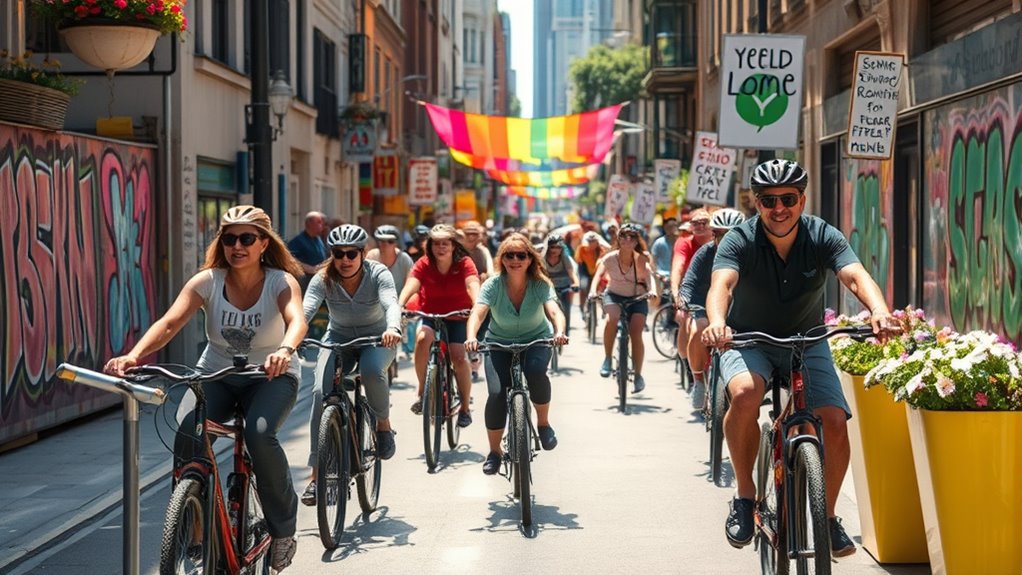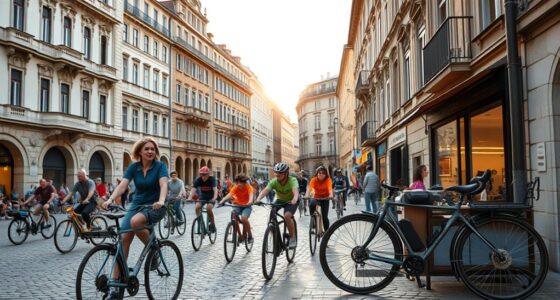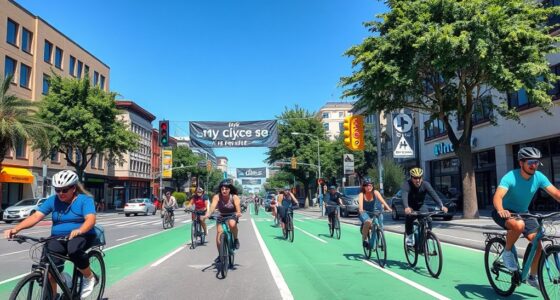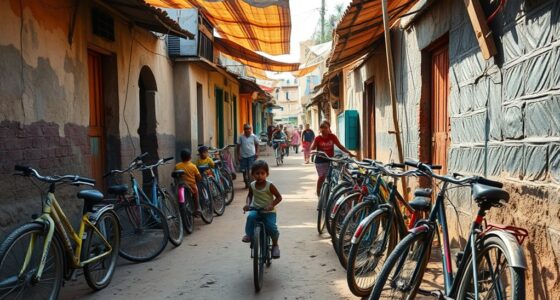Grassroots movements are reshaping cycling culture worldwide by rallying communities to push for safer, more inclusive, and sustainable bike environments. They started locally, advocating for better infrastructure and policies, and then grew into global efforts like Cycling Without Age, which promotes social connection through accessible bike programs. These initiatives focus on community engagement, cultural shifts, and digital tools to inspire change. If you want to see how these movements are creating lasting impact, there’s more to explore.
Key Takeaways
- Grassroots movements advocate for safer, bike-friendly infrastructure and policies, shaping national cycling strategies through community engagement.
- Inclusive initiatives target marginalized groups, promoting equity and cultural shifts toward cycling as a social and utilitarian activity.
- Community-led events and education programs foster diverse participation, normalizing cycling across age, gender, and socioeconomic lines.
- Global campaigns leverage digital tools and storytelling to amplify local successes and mobilize broader support for cycling advocacy.
- Partnerships with urban planners and local organizations integrate grassroots insights into sustainable urban cycling infrastructure.
Origins and Evolution of Grassroots Cycling Advocacy
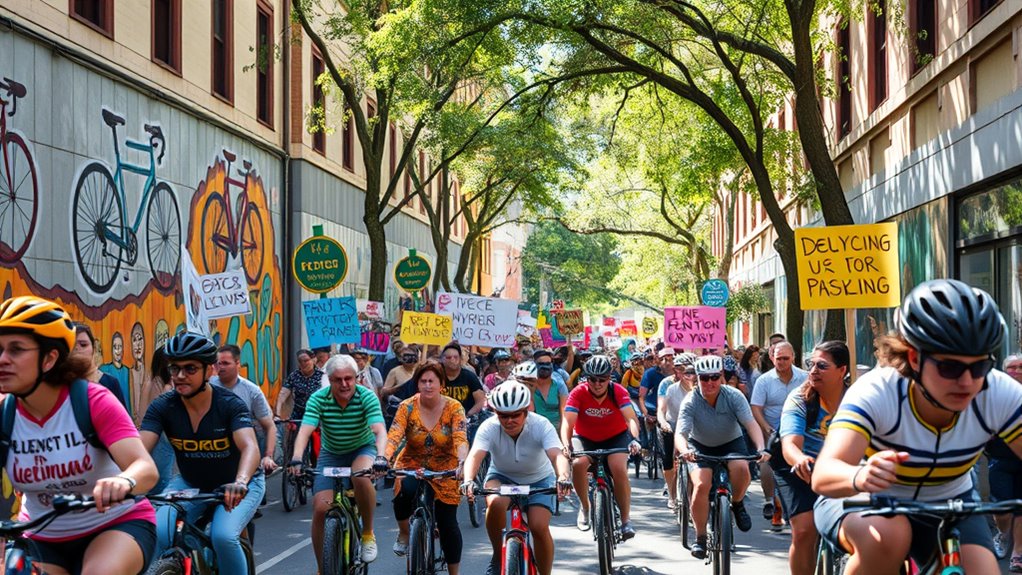
The origins of grassroots cycling advocacy trace back to local communities recognizing safety concerns and working to improve cycling infrastructure. You might’ve seen neighbors organizing events or petitioning local authorities to add bike lanes or fix hazards. A key aspect of these efforts often involved utilizing community engagement strategies to rally support and raise awareness about cycling issues. Early advocates formed small groups to push for bike-friendly policies in their neighborhoods, engaging residents through meetings and community activities. These efforts often involved partnerships between cycling groups and local organizations, creating shared strategies to expand cycling access. As successes grew, these movements inspired broader action, encouraging other communities to follow suit. Over time, grassroots advocates expanded their goals, focusing not only on safety but also on environmental and health benefits. Their creative tactics and collaboration helped shape local infrastructure and fostered a cultural shift toward embracing cycling as a sustainable transportation option. Additionally, leveraging public awareness campaigns allowed these groups to reach wider audiences and amplify their impact. Moreover, the use of social media platforms has significantly enhanced their ability to organize and advocate effectively on a larger scale, often utilizing bike-friendly infrastructure as a tangible goal to motivate community involvement.
Empowering Communities Through Bicycle Access Initiatives
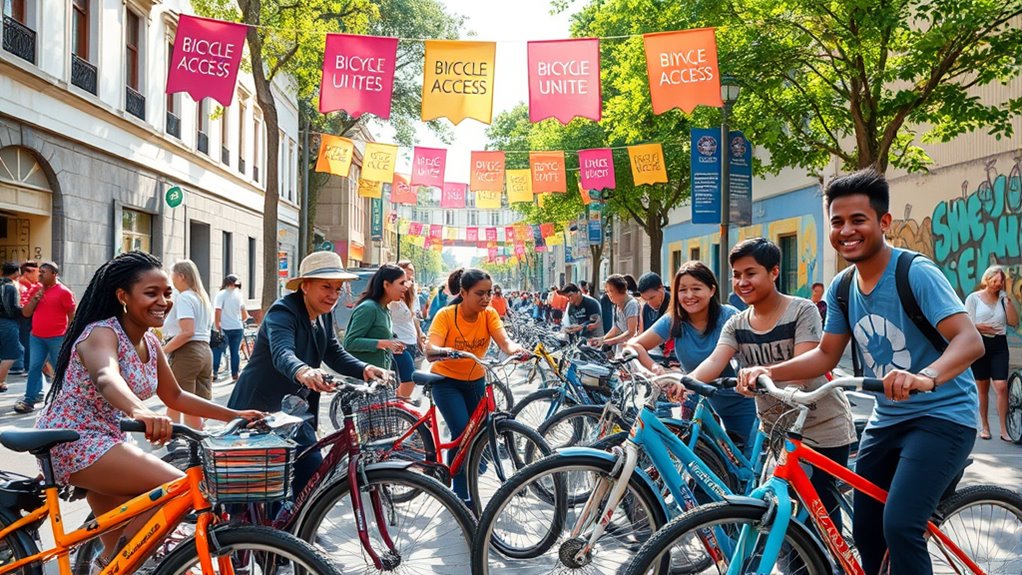
Building on the momentum of grassroots cycling advocacy, communities are now taking deliberate steps to expand bicycle access through targeted initiatives. Bike share programs, like BikeLA’s partnership with Metro Bike Share, focus on increasing access for underrepresented groups—seniors, women, and people of color.
Community outreach efforts emphasize education to guarantee everyone can access cycling resources. Improving bike infrastructure makes riding safer and more inclusive, while inclusive policies support low-income and marginalized communities. Recognizing the importance of urban planning in creating accessible cycling environments helps ensure long-term sustainability. Incorporating community engagement strategies fosters stronger support networks and encourages diverse participation.
Collaborations between local organizations and governments help create more welcoming cycling environments. Community rides and events engage residents, raise awareness, and advocate for better bike lanes.
Safety training, repair workshops, and resource distribution empower individuals to ride confidently and maintain their bikes, fostering a more equitable cycling culture for all. Additionally, implementing vertical storage solutions can optimize space in bike storage areas, making cycling infrastructure more efficient and accessible.
The Global Reach of Cycling Without Age
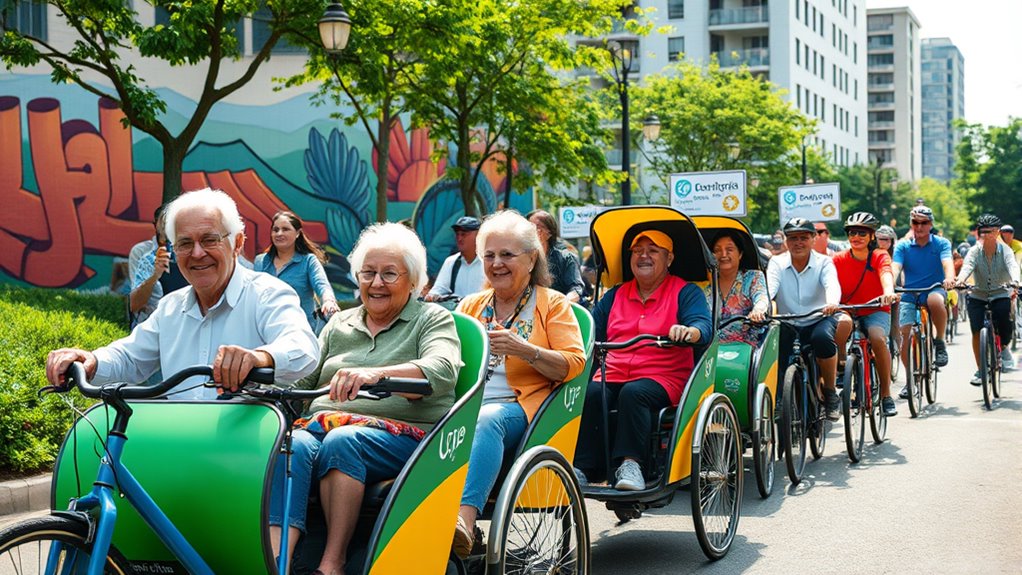
Since its inception in Denmark in 2012, Cycling Without Age has rapidly expanded across the globe, reaching over 50 countries by 2021 and more than 51 by 2020. Today, over 3,050 chapters operate worldwide, with more than 4,900 trishaws helping elderly neighbors enjoy outdoor rides. You’ll find this movement thriving in diverse communities, driven by local volunteers called pilots who give their time freely. More than 39,000 pilots are active globally, promoting inclusion and social connection. The initiative has raised over 25 million EUR, mainly managed locally, ensuring funds benefit each community directly. Cycling Without Age’s global reach exemplifies how grassroots efforts can foster social change, improve well-being, and challenge age barriers through community-driven cycling experiences. Additionally, the use of sustainable transportation methods like trishaws aligns with environmentally friendly practices that promote cleaner air and reduce pollution. Recognizing the importance of mental health, these outdoor activities provide not only physical benefits but also vital social interactions that combat loneliness and depression among the elderly. Moreover, the movement demonstrates how community engagement can be a powerful tool in addressing social isolation and building resilient neighborhoods. Furthermore, the emphasis on low-impact exercise supports physical health and ensures accessibility for elderly participants of varying mobility levels. The success of this grassroots movement also highlights the significance of local leadership in sustaining community initiatives and inspiring broader participation.
Building Inclusive Event Communities in Cycling
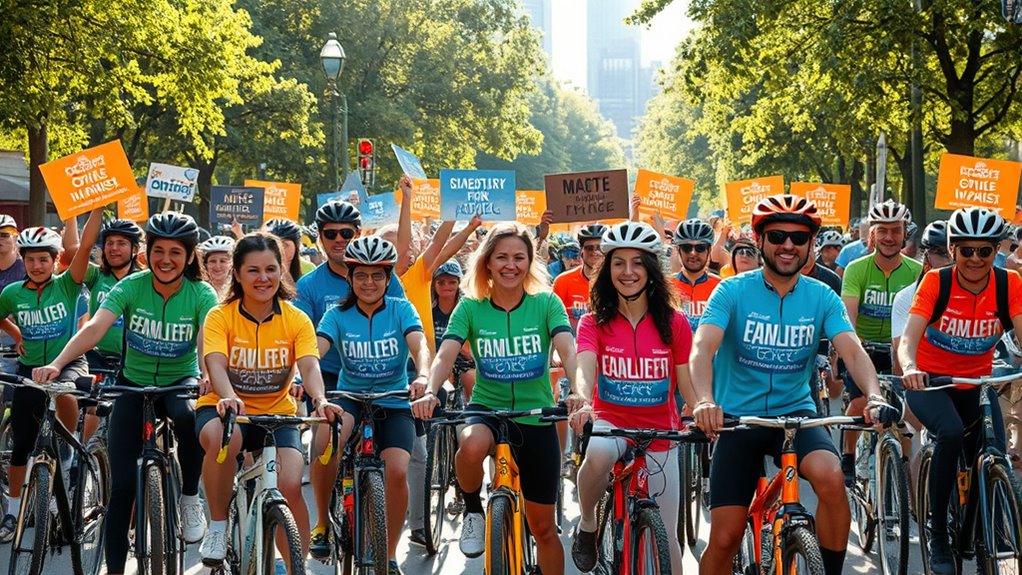
Creating inclusive event communities in cycling requires intentional efforts to engage diverse participants and remove barriers to participation. You can do this by organizing community rides, advocacy opportunities, and educational programs that welcome everyone.
Partnering with groups like Bike POC and All Bikes Welcome helps reach underserved populations, offering free or low-cost rides and accessible infrastructure. Incorporating inclusive design in event planning ensures that facilities and activities accommodate all participants, regardless of ability or background.
Ensuring venues have ADA-compliant routes, varied terrain, and adaptive equipment makes events accessible for all abilities. Promoting equity-focused planning helps address systemic barriers and fosters a truly inclusive environment for all cyclists. Additionally, understanding the importance of sugar content in candies can be used to promote healthier snacks at community events, encouraging better nutritional choices among participants.
Incorporating innovative materials from the latest sneaker trends can inspire sustainable and performance-enhancing gear for cycling apparel, aligning with the goal of inclusivity and advancement. Use inclusive branding and multilingual outreach to connect with broader communities.
Incorporate feedback from participants with disabilities and include them in planning.
Trained volunteers support navigation and safety, while scholarships reduce financial barriers.
These strategies foster a welcoming environment, empowering everyone to enjoy cycling and build a more inclusive cycling culture globally. Recognizing the importance of energetic alignment can further enhance the collective spirit and motivation within community initiatives.
Influencing Policy and Infrastructure for Cycling Growth
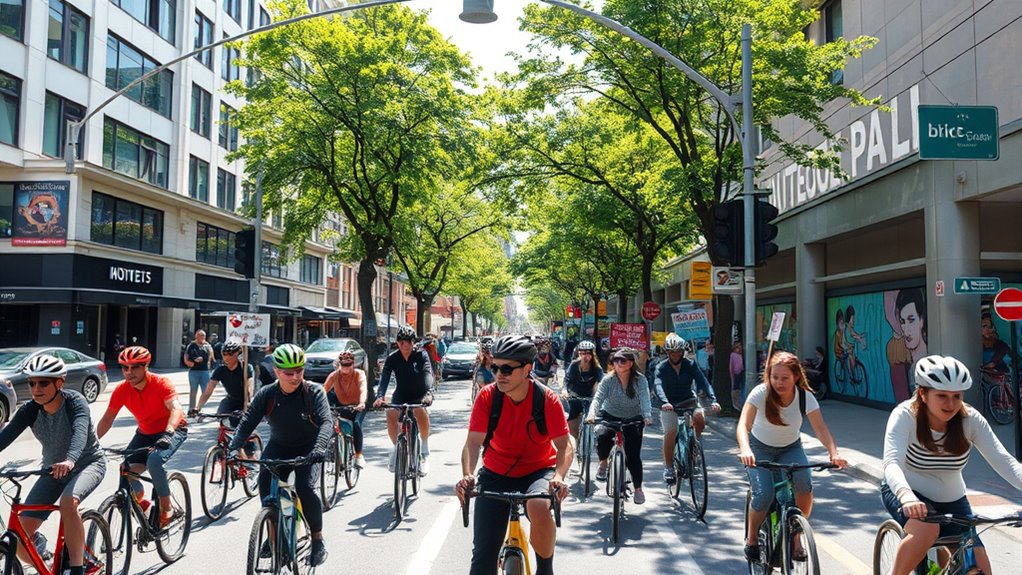
Grassroots movements play an essential role in shaping cycling policies and infrastructure by actively advocating for change and engaging with local authorities. You can mobilize community members to push for better cycling laws and safer infrastructure, fostering collaboration with officials to prioritize cycling needs. Through dialogue, grassroots groups influence legislation, as seen in places like Copenhagen and the Netherlands, where local activism helped shape national policies. Your efforts also include educational outreach to urban planners and policymakers, aligning policies with community aspirations. Additionally, you can advocate for improved public spaces, safer bike lanes, and bike-share programs while researching best practices from around the world. Despite funding challenges, grassroots initiatives use grants and external support to sustain their influence and drive sustainable cycling development. Incorporating Cultural Intelligence (CQ) strategies can enhance engagement with diverse stakeholders and ensure that initiatives are culturally sensitive and inclusive. Moreover, successful grassroots efforts often draw inspiration from local cultural values to tailor their approaches effectively. Emphasizing community engagement is crucial for building trust and ensuring that initiatives resonate with local populations. Recognizing the importance of public support can significantly increase the likelihood of policy adoption and long-term success.
Cultivating Cultural Shifts and Social Inclusion
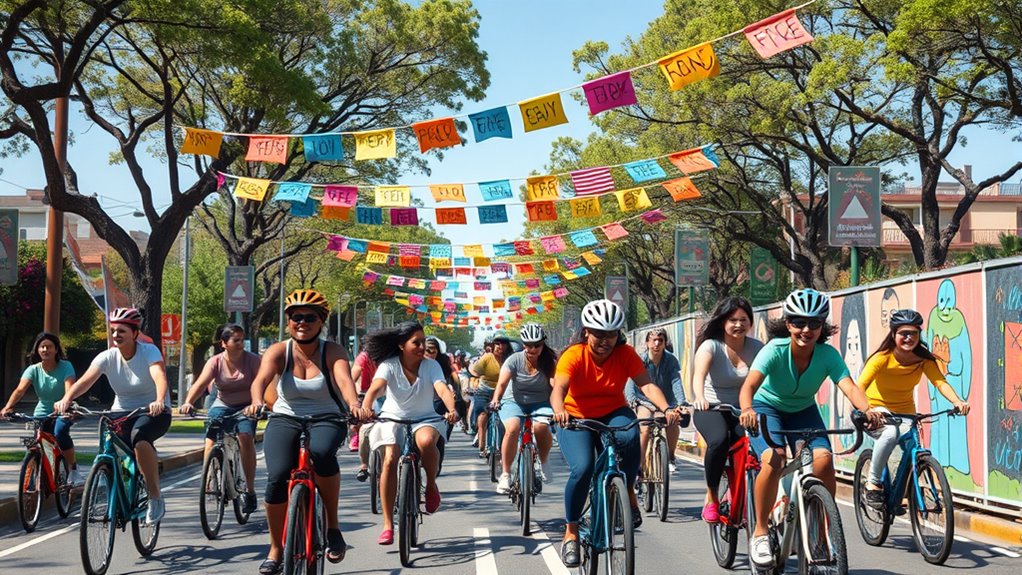
Community-led efforts not only influence policies and infrastructure but also drive cultural shifts that make cycling more inclusive and socially meaningful. Through grassroots initiatives like bi-weekly rides in Addis Ababa, you help foster dialogue on safety and sustainability, creating spaces where diverse voices are heard.
Community initiatives foster inclusive cycling cultures and amplify diverse voices for social change.
Movements position bicycles as tools for equity, challenging car-centric norms and encouraging utilitarian cycling over sport. By prioritizing marginalized groups—such as women through targeted training—you promote broader participation.
Inclusive events with multi-generational and language-diverse outreach normalize cycling across all ages and backgrounds. These efforts transform urban social dynamics, turning cycling into a social equalizer that builds community, enhances interactions, and reclaims public spaces.
Your involvement helps shift perceptions, making cycling a powerful force for social inclusion and cultural change.
Leveraging Digital Platforms for Grassroots Mobilization
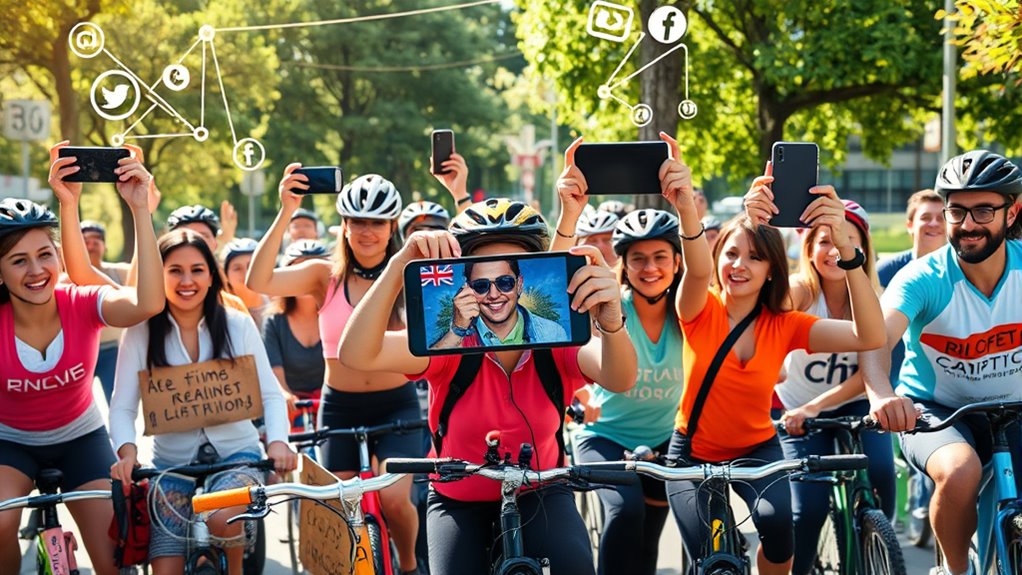
Digital platforms have become essential tools for grassroots movements to coordinate efforts and expand their reach. You can use phone banking apps and voter tracking software to mobilize thousands of volunteers, canvassing neighborhoods and making calls efficiently.
Centralized digital systems streamline scheduling, communication, and administrative tasks, saving time and reducing errors. Automated workflows free up organizers to focus on community engagement instead of manual chores.
These tools also manage large volunteer networks, coordinating dozens of events effortlessly. Digital platforms enhance accessibility by enabling remote participation and designing inclusive interfaces for diverse users.
They foster peer networks for skill-sharing and use data analytics to target marginalized groups. Additionally, storytelling platforms and social media amplify local successes globally, inspiring broader participation and advocacy.
The Future of Localized and Sustainable Cycling Movements
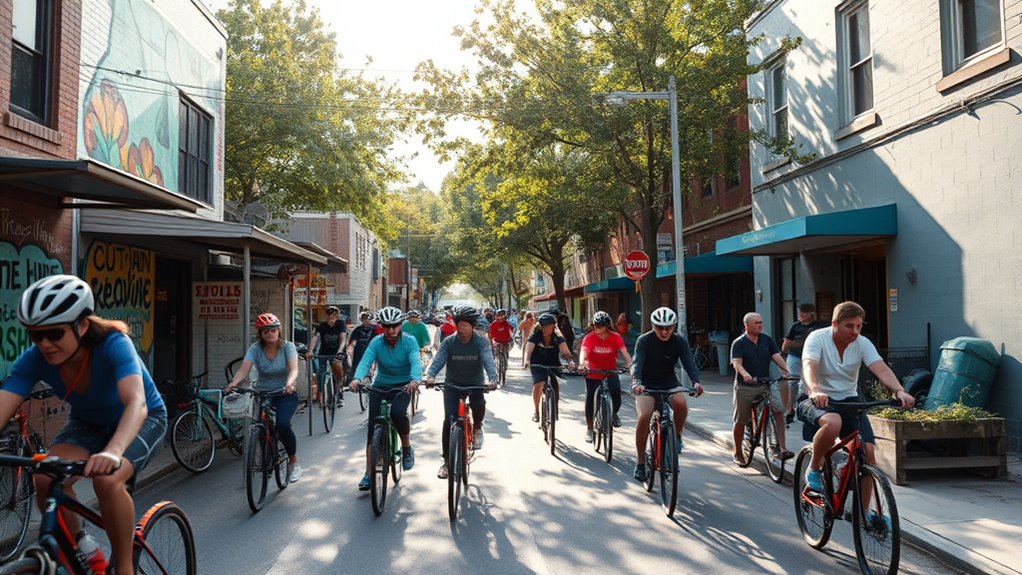
Innovative infrastructural projects are transforming how neighborhoods and cities embrace cycling, making it safer and more accessible for everyone. You’ll see expanded safe cycling networks in rural areas, connecting short trips with public transit, and bike lane integration in urban planning to boost commuter safety.
Climate-resilient routes are designed to withstand extreme weather, ensuring year-round access. Collaborations with experts like Copenhagenize help create cycle-friendly cities, while mixed-use pathways reduce car dependency in suburbs.
Climate-resilient routes ensure year-round cycling, supported by expert collaborations and mixed-use pathways that cut car dependency.
Community-led initiatives, such as local cycling collectives and bike repair workshops, empower residents and promote sustainability. These movements also integrate eco-friendly tourism, with bikepacking routes and low-impact accommodations.
Policy reforms, like tax incentives and cross-border agreements, further support these efforts, shaping a future where cycling becomes a central part of vibrant, sustainable communities.
Frequently Asked Questions
How Do Grassroots Groups Sustain Long-Term Cycling Engagement Locally?
You can sustain long-term cycling engagement locally by organizing diverse events like group rides and bikeathons that keep the community interested. Encourage participation from all ages, especially youth, and strengthen local clubs to build capacity.
Use social media to promote events and success stories. Collaborate with local organizations and authorities to improve infrastructure and policies, ensuring ongoing support.
This will help create a vibrant, active cycling culture that lasts.
What Challenges Do Grassroots Organizations Face When Scaling Globally?
When scaling globally, you face challenges like adapting strategies to diverse cultural norms and infrastructure realities. Resistance to familiar models, language barriers, and limited resources hinder progress.
You also deal with decentralized networks requiring coordination, inconsistent funding, and political hurdles that can stall projects. Additionally, balancing local priorities with global goals, maintaining safety standards, and overcoming opposition from powerful industries make expansion complex yet essential for broader cycling adoption.
How Do These Movements Measure Their Social and Environmental Impacts?
Did you know that 75% of grassroots cycling groups track their impact? You can measure social effects through surveys on community cohesion and health, and environmental benefits via carbon footprint analysis.
What Role Do Local Governments Play in Supporting Grassroots Cycling Initiatives?
You see, local governments play a vital role in supporting grassroots cycling initiatives by providing funding, policy changes, and infrastructure. They offer mini-grants, matching funds, and public-private partnerships to boost projects like bike libraries and safety workshops.
Additionally, they implement safe cycling laws, expand protected bike lanes, and install secure parking. Their support fosters community engagement, making cycling safer, accessible, and more inclusive for everyone.
How Do Grassroots Movements Adapt to Diverse Cultural Contexts Worldwide?
They say “different strokes for different folks,” and that’s true for grassroots movements adapting to cultural contexts.
You’ll find that you need to listen to local communities, respect traditions, and tailor your message to resonate with diverse values.
Conclusion
By embracing grassroots movements, you become part of a global shift—shaping communities, inspiring change, and fostering inclusion. You empower others through access, advocate for better infrastructure, and build inclusive events. You leverage digital platforms to mobilize, challenge policies to promote cycling, and cultivate cultural change rooted in sustainability. Together, you drive transformation—locally, globally, sustainably—because when you ride for change, you ride for a better world.
